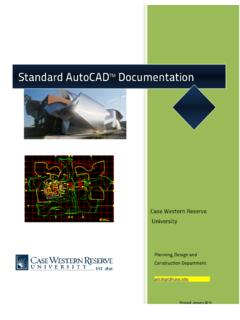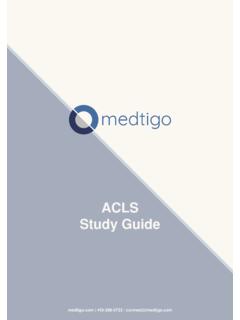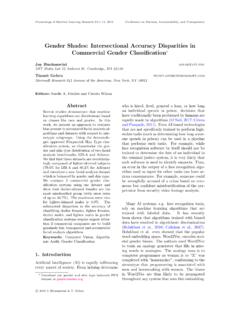Transcription of Breast Cancer Study Case
1 1 Breast Cancer Study CASE Scenario A Carol Edwards, a 39 year-old premenopausal woman, had a screening mammogram which revealed an abnormality in the right Breast . She had no palpable masses on Breast exam. A mammographically localized surgical biopsy was done and revealed a small ( cm) grade III infiltrating ductal carcinoma with some associated ductal carcinoma-in-situ (DCIS). The surgical margins were not clear ( Cancer cells were found at the posterior margin). Estrogen and progesterone receptors are negative. The patient has been given the diagnosis in a telephone conversation with the surgeon a few days after the biopsy, and they are now meeting to discuss definitive treatment. Surgical treatment must address two issues: local control and staging. LOCAL CONTROL can be achieved by mastectomy or by wide re-excision (known as lumpectomy or partial mastectomy) followed by radiation to the Breast .
2 The latter is known as Breast conservation therapy (BCT) and it is imperative that margins be clear and cosmetic results acceptable to the patient to qualify for this option. In addition to this, there must be unifocal disease only, not multicentric cancers. If there are multiple foci of carcinoma, the patient should have a mastectomy. Following healing, radiation to the remaining Breast tissue is generally administered over a 6 week period (5 days/week). Side effects are minimal, consisting of fatigue and some local swelling and minor soreness of the Breast with associated erythema (and occasionally sloughing of the epidermis which will heal). If chemotherapy is required, the radiation is scheduled to follow the completion of the chemotherapy; radiation and chemotherapy are not, as a rule, administered concomitantly. Radiation following total mastectomy is only recommended in select cases in patients with inflammatory Breast Cancer and in patients with locally advanced disease (as manifested by tumor size >5 cm and/ or with 4 or more positive nodes).
3 SURGICAL STAGING (to determine if there are regional metastases) is done by axillary lymph node dissection (ALND). There are no radiologic methods to reliably detect nodal metastases; microscopic confirmation must be achieved by removing some of the axillary nodes. Axillary node status is the single most important prognostic factor in determining Breast Cancer survival. Regardless of which local control option is desired, mastectomy or lumpectomy with radiation, ALND should be done. In this particular patient the information is especially important as it will determine whether or not adjuvant chemotherapy will be recommended. Because her hormone was hormone receptor-negative, the use of tamoxifen is not an option. For patients with tumors that have a favorable prognosis (as defined by size smaller than 1 cm and negative nodes) the potential benefits of adjuvant chemotherapy are probably outweighed by the risks.
4 However, if nodes are positive, chemotherapy should improve survival. The information in bold type below is from UpToDate: 2 INTRODUCTION The lymphatic drainage pathways of the Breast (axillary, internal mammary [IM], and supraclavicular nodal groups) are the regional areas most likely to be involved with metastatic Breast Cancer . RISK FACTORS FOR AXILLARY NODE INVOLVEMENT The axillary lymph nodes (ALNs) receive 85 percent of the lymphatic drainage from all quadrants of the Breast ; the remainder drains to the IM chain. The likelihood of ALN involvement is related to tumor size and location, histologic grade, and the presence of lymphatic invasion. Tumor size and margins The likelihood of ALN involvement increases as the size of the primary tumor increases. In one series of 2282 women with invasive Breast Cancer or ductal carcinoma in situ (DCIS), the incidence of ALN involvement was as follows: Tis percent T1a 5 percent T1b 16 percent T1c 28 percent T2 47 percent T3 68 percent T4 86 percent ALN metastases are relatively common even with invasive Breast cancers 1 cm in size.
5 In a second report of 919 such women who underwent ALN dissection (ALND); ALN metastases were detected in 16 and 19 percent of those with T1a (tumor size between and cm in greatest dimension) and T1b tumors (tumors between and cm), respectively. Many database series report a higher rate of ALN metastases for T1a than T1b disease. The higher rate in this group may be related to multifocal disease in DCIS, undersampling of the primary tumor, or high grade microinvasive carcinoma. Nodal positivity rates are also higher in women who are found to have residual tumor after reexcision for positive margins following lumpectomy for Breast conservation therapy (BCT). In one series, women with T1b tumors who had residual disease were significantly more likely to harbor ALN metastases than those whose tumors were either excised to a negative margin initially or who had negative reexcisions for an initially positive margin (36 versus 5 percent).
6 Histologic features Low grade (grade 1) tumors have a significantly lower rate of ALN metastases compared to grade 2 or 3 tumors. As an example, in data derived from the Surveillance, Epidemiology and End Results (SEER) database, the incidence of ALN disease in patients with grade 1 and grade 3 tumors of similar size was and 21 percent, respectively. The presence of lymphatic invasion also increases the risk of ALN metastases. 3 Tumors that are associated with a less than 5 percent risk of ALN metastases include those with a single focus of microinvasion, <5 mm grade 1 tumors without lymphatic invasion, and pure tubular carcinomas <1 cm. Tumor location ALNs are more commonly involved with tumors involving the lateral rather than the medial portion of the Breast . As an example, in a series of 8422 patients enrolled on International Breast Cancer Study Group trials between 1978 and 1999, the rate of node-negativity for medial compared to lateral/central tumors was 44 versus 33 percent, respectively.
7 The most likely explanation for this difference is preferential drainage of some medial tumors to the IM nodes. As with all surgical procedures, there are some risks associated with Breast surgery. At the lumpectomy site, the patient may develop a postoperative wound infection or hematoma, but the likelihood is small. These complications can be seen with mastectomy as well. Development of a persistent postoperative fluid collection (known as a seroma) is also a possibility. Two major motor nerves reside in the axilla, the long thoracic nerve, which innervates the serratus anterior, and the thoracodorsal nerve, which innervates the lattissimus dorsi. The likelihood of injury to these is extremely small. Intercostobrachial nerves traverse the axilla as well, supplying sensation to the skin of the axilla and posterior upper arm. These may be divided or otherwise injured during the node dissection, resulting in temporary or permanent numbness.
8 However, the most feared and significant complication associated with ALND is the development of lymphedema of the upper extremity. This condition occurs in approximately 10-15% of those who undergo ALND and can occur shortly after surgery or several years later. This swelling is felt to be secondary to impeded lymph flow through the scarred nodal basin and is often triggered by a break in the skin or some other type of inflammation which results in extra fluid in that extremity. The degree of lymphedema is variable but it can be difficult to treat successfully. Patients are urged to avoid injections, phlebotomy and placement of venous catheters in that extremity, and must be encouraged to exercise extra caution while performing simple tasks in the kitchen, the garden or at work to avoid breaks in the skin . Arm morbidity Shoulder stiffness, and numbness and paresthesias in the upper arm are common complaints following ALND; although they do not usually interfere with daily living, they may impact on quality of life (QOL).
9 In one series, 42 percent of women had subjective or objective arm impairment (eg, pain, reduced grip strength) one year postoperatively. The likelihood of arm edema is higher in women who undergo more extensive ALND, and combined axillary surgery and RT. The use of SLN biopsy is associated with fewer arm complications than full ALND. SENTINEL NODE BIOPSY According to the sentinel lymph node (SLN) hypothesis, tumor cells migrating from a primary tumor colonize one or a 4 few lymph nodes (LNs) before involving other LNs. Peritumoral injection of a vital blue dye permits identification of an SLN in the majority of patients, and its status accurately predicts the status of the remaining regional LNs. The concept of lymphatic mapping and SLN biopsy (SLNB) was initially developed for penile Cancer and has been best studied in melanoma. In Breast Cancer , SLNB has been explored as a less morbid alternative to axillary lymph node dissection (ALND).
10 In theory, a properly performed negative SLNB should eliminate the need for completion ALND. The risk of lymphedema is significantly lower after SLNB than ALND. Although many surgeons have adopted this approach, whether SLNB adversely influences survival compared to ALND is not yet proven. Since the magnitude of such a survival difference, if it exists, is expected to be 5 percent or less, definitive proof requires a very large trial. At least four are underway. Preliminary reports from the NSABP and ALMANAC trials presented at the 2004 San Antonio Breast Cancer symposium are encouraging, suggesting that short term survival and recurrence rates are similar with and without ALND. At least in the ALMANAC trial, QOL was superior with SLNB. Nevertheless, until long-term follow-up is available for these and other trials, there will be persisting concerns about a possible survival detriment if ALND is not performed.















